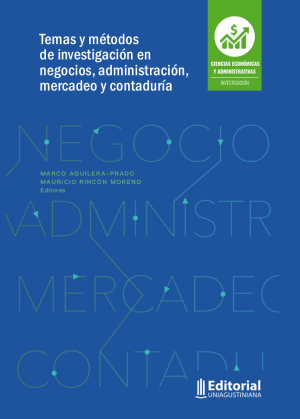
Temas y métodos de investigación en negocios, administración, mercadeo y contaduría
Economista, Universidad Autónoma de Occidente. Magíster en Economía, Pontificia Universidad Javeriana. Estudiante del Doctorado en Economía Aplicada de la Universidad Autónoma de Barcelona, España. Docente del programa de Contaduría Pública de la Uniagustiniana, Bogotá, Colombia.
Economista, Universidad Autónoma de Occidente. Magíster en Planificación y Administración del Desarrollo Regional, Universidad de los Andes. Candidato a Doctor en Ingeniería de la Universidad Distrital Francisco José de Caldas. Profesor Vicerrectoría de Investigaciones, Uniagustiniana, Bogotá, Colombia.
Profesional en Negocios Internacionales, Universidad de Medellín. Magíster en Estudios Políticos, Universidad Pontificia Bolivariana. Profesora Negocios Internacionales, Universidad de Medellín, Colombia.
Politóloga, Universidad Nacional de Colombia. Magíster en Investigación Social Interdisciplinaria, Universidad Distrital Francisco José de Caldas. Profesora Negocios Internacionales, Uniagustiniana, Colombia.
Profesional en Relaciones Internacionales, Colegio Mayor Nuestra Señora del Rosario. Magíster en Asuntos Internacionales, Universidad Externado de Colombia. Profesora Negocios Internacionales, Uniagustiniana, Colombia.
Economista y Magíster en Economía Internacional, Universidad Nacional de Colombia, sede Medellín. Profesor Contaduría Pública y Maestría en Contabilidad Internacional y de Gestión, Universidad de Medellín, Colombia.
Economista, Universidad Autónoma de Pereira. Magíster en Economía Matemática, Universidad Autónoma San Luis Potosí, México. Profesor Contaduría Pública, Uniagustiniana, Bogotá, Colombia.
Economista y Magíster en Estudio y Gestión del Desarrollo, Universidad de la Salle. Estudiante del Doctorado en Agrociencias de la Universidad de la Salle. Profesor Administración de Empresas, Uniagustiniana, Bogotá, Colombia.
PhD. in Engineering, Industry and Organizations, Universidad Nacional de Colombia. Marketing Professor, Uniagustiniana, Bogotá, Colombia.
Phd. in Marketing, Strirling University, UK. Professor at Department of Organizations Management, Pontificia Universidad Javeriana, Cali, Colombia.
Administrador de empresas, Fundación Universitaria Los Libertadores. Magíster en Administración, Universidad Nacional de Colombia. PhD (c) Economía y Empresa, Universidad Jaume I. PhD (c) en Humanidades, Humanismo y Persona, Universidad de San Buanventura. Director de Investigaciones, Uniagustiniana, Bogotá, Colombia.
Este texto se presenta como una guía de investigación para estudiantes de posgrado, profesores de metodología de investigación, investigadores en carrera y grupos y centros de investigación de las áreas de negocios, administración, mercadeo y contaduría, cuyo objetivo es esclarecer el conjunto de temas y métodos empleados por la comunidad científica internacional de esos campos del conocimiento. La construcción de los capítulos se sustenta en revisiones sistemáticas de la literatura y bibliometrías, a partir de publicaciones recientes de alto impacto, las cuales fueron seleccionadas de Scopus y Web of Science. De manera general, los resultados señalan que i) la literatura de alto impacto se produce en Estados Unidos, Reino Unido y Alemania; ii) existen ámbitos de análisis, contextos de problematización y campos de aplicación variados para la investigación en estas áreas de interés; iii) a pesar de que la organización es el foco de la investigación en estas áreas, en el tiempo reciente se ha enfatizado en su relación con el entorno nacional e internacional y el estudio de las personas en ese ámbito; y iv) la presencia de la teoría económica sigue siendo vigente como simiente de la literatura de impacto en estas áreas.

Esta obra está bajo una licencia internacional Creative Commons Atribución-NoComercial-CompartirIgual 4.0.
Universitaria Agustiniana
Personería Jurídica No 6651 de 1996 - Resolución 780 febrero de 2009. Institución de Educación Superior sujeta a inspección y vigilancia por el Ministerio de Educación Nacional
Campus Tagaste: Avenida Ciudad de Cali No. 11b-95
Campus Suba: Calle 147 No. 89-39, Parque Principal
PBX: (57) (1) 4193200
Ciudad Bogotá DC


